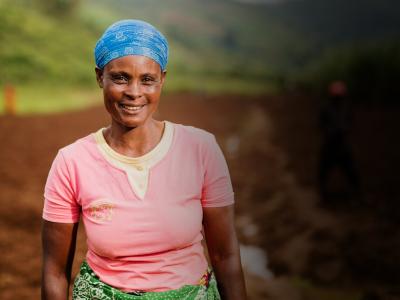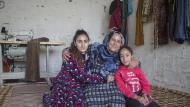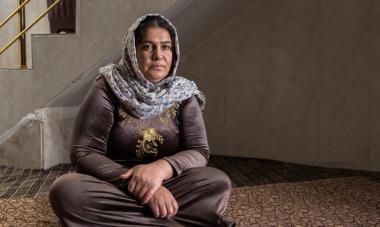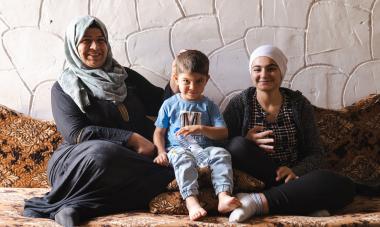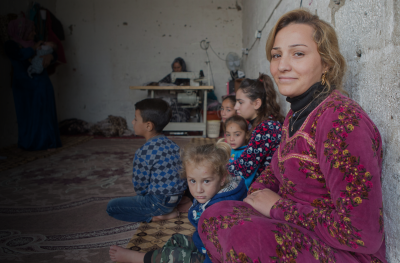The amount of forcibly displaced people has reached a staggering number—over 114 million according to UNHCR—and the number only continues to increase.
Our world has experienced political, social and cultural upheaval unmatched by any other period in our history. New and continued conflicts compounded by the economic impacts of coronavirus is forcing hundreds of millions out of their homes and into a world without healthcare or social support systems.
As the war in Ukraine wages on, new conflicts continue to unfold, from Sudan to Kosovo, and the survivors of the earthquake in Syria rebuild their lives (some for the second time). The number of people seeking refuge outside of their home countries or displaced within is higher than ever - and women and girls are disproportionately affected. Around the world, ethnic tensions, political strife, famine, climate change and terrorism continue to uproot lives.
As inequality gaps widen and displacement increases, it’s up to us to invest in providing the opportunities and services to support women refugees during this time and as they rebuild.
Fact 1: 1 in 5 women refugees experience sexual violence.
Women refugees and internally displaced women suffer from marginalization, sexual and gender-based violence and child marriage. Some experience sexual and gender-based violence as they flee conflict.
In camps or due to poverty, some women and girls may be kidnapped, trafficked or forced into marriage. 9 out of 10 countries with the highest rates of child marriage are considered either fragile or extremely fragile states, where long-ingrained gender norms pressure girls into vulnerable situations. And we have seen the number of women raped and sexually abused while internally displaced due to the war in Ukraine soar too.
Fact 2: Women and children make up most of the people forcibly displaced by renewed conflict in Syria.
Before the Türkiye-Syria earthquakes, Syria's 13-year war had already displaced half of the country’s pre-war population of 23 million.
Now, there are 6.7 million people displaced within Syria and more than 18,000 registered refugees and asylum-seekers in the country. Nearly 70% of their population is women and children - and too many are forced into surrounding areas, some in camps where resources are scarce and weather conditions harsh.
In places like Syria, where women had been making advances in gender equality, disease and displacement threaten that progress. And for many displaced by the earthquakes, estimated to be over 50,000 families in Syria alone, this is their second experience of displacement.
Fact 3: 50 percent of refugees, internally displaced, or stateless populations are women and girls.
Of the over 100 million people who have been forced into displacement, over half are women and girls. Women are often the first responders when crisis hits yet their voices are often left out of policies that are designed to protect them. In addition to poverty and other issues that all refugees may face, women refugees have an added layer of oppression from gender discrimination.
Fact 4: South Sudanese and other refugees in Sudan have been forced to return to their home countries as conflict has soared.
Even before the recent uptick in conflict, Sudan was battling extreme weather, social and political unrest and rising food prices - exacerbated by the war in Ukraine's global impact. Nearly 1.4 million people have been displaced from their homes. For many, this is not the first time.
With no end to the violence in sight, people are desperately seeking safety, both within Sudan itself and in bordering countries, such as Chad, South Sudan, Egypt, Ethiopia and the Central African Republic. For hundreds of thousands of people, this has meant returning to their home countries under dangerous conditions.
Fact 5: Refugee women could generate and contribute $1.4 trillion to the annual global GDP.
Contrary to the myth that refugees are unskilled and uneducated, many of them have much to contribute. While some refugees might have never had the chance to gain formal education, many are highly educated and highly skilled.
Many refugees face barriers to inclusion in local economies, which makes finding stability for their families a challenge. Negative economic impacts related to coronavirus structures have made finances harder. For women refugees, the barriers are even higher as gender discrimination closes doors or leads to lower pay. Yet if we invested in economic opportunities for women refugees, we could help close gaps in poverty, gender equality and inclusive work – all while helping economies on a local and global scale.
Throughout the years, Women for Women International has been able to witness firsthand the dangers and obstacles faced by refugees. They have barely escaped war, and many refugee women face threats of gender-based sexual violence and early marriage in their pursuit of safety.
